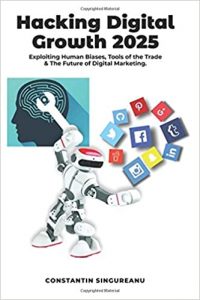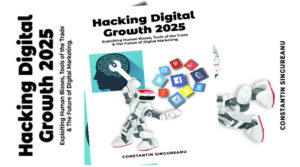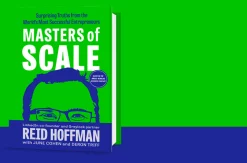Hacking Digital Growth 2025: Exploiting Human Biases, Tools of the Trade & The Future of Digital Marketing by Constantin Singureanu
About The Book:

Hacking Digital Growth 2025 by Constantin Singureanu, exposes you to the technological forces affecting the future of growth hacking and digital marketing: Big Data, Artificial Intelligence, Machine Learning, Voice Search, and more. You will be exposed to a wide range of psychological principles, and how they affect human judgment when people purchase things online.
Learn how to make use of fear, depression, the myth of “less is more”, first impressions, last impressions, priming, networks, obedience, and many more, to your advantage. You are also introduced to a wide range of growth hacking tools that will support your mission of hijacking the minds of your audiences.
The book approaches digital marketing and growth hacking both from a scientific and practical perspective. We live in a rapidly changing world where new ideas are quickly replacing popular ones and changing the rules without mercy. Where will your business be in the next 5 to 10 years? This book will enable you to both stays ahead of the competition and transform your business.
Are you ready to transform your business for the future? What you will find inside:
1. The book discusses the introduction and influence of disruptive technologies that are changing the digital marketing landscape including Big Data, Artificial Intelligence, Machine Learning or Voice Search.
2. A thought-provoking conversation about the future of digital marketing, tools, and profession. Ranges of elements are discussed, from SEO, paid search, and native advertising, to data analytics, content, and email marketing.
3. Non-technical marketers, business owners, sales teams, digital marketers, and entrepreneurs are introduced to a wide range of digital marketing tools, software, and resources, which they can use to transform their ventures and successfully compete in the business environment.
4. Outsourcing platforms have changed everything, making it easy for entrepreneurs to purchase content and do almost anything within a very flexible marketplace. You’ll also learn about the importance of so many digital marketing resources like social media follower automation, landing page creation, automated posting, commenting and liking, etc., to drive quality traffic and boost sales to your website.
5. The book also discusses tools for generating content ideas, leveraging popular content, performing sentiment analysis on your content and more. Readers are also introduced to a variety of growth hacking and digital marketing tools they can use to bring ideas to life and create content that will resonate with their followers or audience. These tools are used for video and video animation, beautiful and colorful images, infographics, video and image editors, memes, Gifs, magazines, etc. You also learn how to utilize eBooks, online courses, mobile apps, webinars, podcasts, etc., to repurpose and extend the reach of your content.
6. Customer engagement is important for online conversion. You learn the importance of digital marketing tools for communication, like live chat, virtual offices, pop-ups, IP mapping, virtual numbers, etc.
7. You also learn about growth hacking tools for reaching journalists, bloggers, media, and influencers in your business, and increase reach to your content using social lockers, follow buttons, push notification, automation of workflow, etc.
8. Digital marketing is already overtaking traditional marketing. Understand the fundamentals of disruptive trends that have been changing digital marketing and growth hacking. Get into the mind of your audience and leverage human nature and digital marketing tools for improving your business.
By the same Author:
DIGITAL MARKETING MADE SIMPLE
– A Jargon-Free Review of Theory, Tools & Leveraging Human Psychology to SELL MORE
MIND THE BRAND GAP
– A study of Competing Brand Identities, Human Biases and Why You MUST FIRE your HR team
Disruptive Digital Marketing 2025
Exploiting Human Biases, Tools of the Trade & The Commoditization of Digital Marketing
Editorial Reviews:
About The Author:

Constantin Singureanu graduated with an MBA and MA in Marketing & Innovation and is currently starting an MSc in Data Science. His current role is Head of Digital Marketing at a London-based company – Move Digital.
In the past, he performed a variety of roles starting with managing hotels for Intercontinental Group and Hilton, launching a variety of restaurant and bar concepts, being a marketing consultant for businesses ranging from SMEs to large iconic brands, to helping savvy entrepreneurs in setting up, launching and growing their exciting start-ups.
Together with his teams, he has won awards for developing people, innovation, customer service, revenue development, sales and was shortlisted for many awards in entrepreneurship, business person of the year, or social influence. His team described him best as “someone who is mentally and physically determined, as well as tough but loveable when needed.”
Review:
Appearance:
Content:
Did You Know: (Book Articles)
Beware the Large Incentive Trap…
One misconception marketers seem to have is that both large incentives and lead magnets will grow email lists and induce commitment. This misconception is mainly due to an assumption of reciprocity: the more I give you, the more you will give me. However, by offering high-value lead magnets or gifts you present your audience with the perfect way to explain away your gift:
“It was the high value gift, rather than my appreciation of the website, that prompted me to download the gift and provide my email details.”
The negative impact of large rewards on people’s perception of a task is well documented. Specifically, when larger rewards are being provided, people engage less in the activity they have been incentivized to perform. (Sutherland, 2007) This is because those people now associate their behavior with the large incentive rather than with enjoyment in performing the activity. Hence, your offer, gift, or lead magnet must be of a low monetary value but high intrinsic value to your audience. In my experience, website owners or digital marketers pay very little attention to creating lead magnets that will engage audiences with their brand, product, or website beyond the transactional level.
In this context, business owners and marketers offer lead magnets with an “I give you this, you give me that in return” mindset. For example, some marketers provide discounts via sticky headers or various pop-ups as a mean of attracting new leads. You see pop-ups promoting discounts or special offers for new customers, brands running discount campaigns in supermarkets, and 50–70 percent reduction offers are being made by retailers throughout the year. The trouble is that, more often than not, discounts do not attract new customers, but rather reduce revenue. Indeed, research by Ehrenberg, Hammond, and Goodhardt revealed that most purchases during discounting campaigns came from people who had purchased the brand previously, hence from existing rather than new customers. (Sharp, 2010) And even when discounts attract new buyers, a large proportion of those buyers are driven purely by price and revert back to their previous buying behavior when the promotion ends.
Psychologists refer to this pattern as the “purchase reinforcement effect.” (Sharp, 2010, p. 157) The motivation for this behavior is easy to see: the large discount allows website visitors to explain away the reason for their purchases in terms of “I bought this product because of the large savings rather because I am committed to the website, brand, or product.” Of course, when promotional campaigns are aimed at increasing short-term sales vs. long-term loyalty acquisition, then price discounts will often meet your goals. In fact, research has shown that on average you can expect increases of around 25 percent from a 10 percent price cut. (Sharp, 2010) One classic example revealing how strong the impact of discounts is on people’s behavior is a phenomenon accidentally discovered by an automobile tire company.
The company had printed in error some batches of discount coupons that in reality offered no discounts at all. The surprise came when the response rate to theses coupons was as high as the response rate to coupons that were actually offering discounts. Hence, simply packaging the deal as a special offer was worthwhile. Another thing to keep in mind, though, is that before deciding on a discounting strategy you must consider yet another effect of price discounts, which is the decline in sales after the promotion.
This could happen because people have purchased more than they would normally buy, or as mentioned above, because people revert to their earlier purchasing behavior. (Sharp, 2010) In the end, if commitment is what you are looking for, then large discounts will merely provide your audience with a way of explaining their purchasing behavior and the reasons for reading your article or for allowing you to add their details to your email list.
But Don’t Be Affraid Of Using Free
For all its popularity, it is surprising to see that many marketers dismiss “Free” as an outdated concept living its last days. The argument is that as people have gotten smarter they now see beyond “Free”. In reality, the belief is caused by the misuse of “Free,” with many businesses lacking understanding of why and how “Free” is supposed to work. Indeed, most businesses use “Free” more as a word than as a psychological principle. They offer “free this” and “free that,” and when it’s not working out as they wanted it to, they come to the conclusion that “Free” doesn’t work.
It was set up to fail. So when does “Free” work? Firstly, the idea of a free gift employs the reciprocity rule. We have already discussed reciprocity earlier in the book. A reminder: on receiving an unexpected favor we feel a significant urge to offer a favor in return. Very often, in order to reduce the cognitive strain we return favors much larger than the favors we receive. However, as previously stated, the free gift you offer on your website must be perceived by your audience as a purple cow, there simply is no way around it.
Too often, people are being met with pop-ups, emails, or other online growth hacking techniques, demanding that they provide their contact details and loyalty in exchange for a product, report, or some other lead magnet that is of little or no value to the them. Even when it works and people do sign up, you are simply allowing your hard-earned visitors to explain away your gift: “I have downloaded simply out of curiosity.”
This, not surprisingly, results in an unsuccessful “Free” strategy. “Free” also employs the reciprocity rule in a more unexpected way. As a digital marketer you often come across various tools offering free trials. Leadfeeder is one such tool that comes to mind. Most people think of free trials as a low risk opportunity offered by companies to showcase their product. Given that digital products are very cheap, if not free, to replicate, free-gift customers most often don’t cost you a thing. From the customer’s point of view, as well, if they like the product they can of course sign up, and if they don’t then no harm has been done.
This perception is sound and makes sense at first glance. However, many experiments have shown that, in a cause-and-effect way, once you take the trial you feel an urge to reciprocate. (Cialdini, 2007) Remember the name of Steve Krug’s book? It was Don’t make me think. “Free” works in that sort of way, as revealed by another experiment by Dan Ariely. Ariely found that, when offered a choice between a 1¢ candy and a 26¢ candy, most people took the 26¢ candy. But when offered a choice between a free candy and the 26¢ candy, most people went for the free option. (Caldwell, 2012) I think we can agree that the difference between 1¢ and free is insignificant, and yet it made such a difference.
I always write my reviews on Amazon, 3ee, Goodreads, LibraryThing, and Social Media such as Facebook, Instagram, Twitter, Linked In, Telegram, and Google+.
If you also have read this book, please share your review below, we greatly appreciate your comment, and let’s talk about it!



